[Retracted] Application of Correlation Filter Tracking Algorithm Based on Multiple Color Features in Basketball Motion Capture System
Abstract
The application of motion capture system in basketball game can intercept the highlights of the game and improve the viewing effect. In order to improve the tracking performance of target tracking algorithm and the efficiency of traditional basketball tracking system, a correlation filtering algorithm combining multiple color features is adopted in this study. A dhcf as algorithm based on multicolor feature is established. The adaptability of traditional KCF algorithm in scene attributes such as rapid target change and illumination change is mainly studied. The success rate of multicolor tracking algorithm can reach 78.2%. At the same time, based on the traditional kernel correlation filter, the algorithm combines the discriminant color descriptor and the direction gradient histogram. The results show that the success rate and accuracy of the algorithm in otb50 are 84.2% and 82.5%, respectively. In addition, excellent tracking performance is reflected in various scene attributes. Therefore, the algorithm can improve the target tracking performance of the traditional kernel correlation filter, especially solving the adaptability of the traditional algorithm in the scene of light change, fast target movement, and so on.
1. Introduction
With the development of information technology, multimedia technology is constantly updated and upgraded and has been applied to many fields. The application of motion capture system in basketball can intercept the highlights of the game and improve the viewing effect. In addition, in basketball training, frame-by-frame analysis of elite athletes’ actions through motion capture technology can improve the teaching quality [1]. The motion capture system needs to capture the movements of the target athletes accurately and quickly. In the process of basketball game, the athletes’ speed is very fast, which is a great challenge to the performance of the system. The traditional tracking algorithm will carry out a large number of sample training in the sampling process, its operation process is more, and the real-time performance of the algorithm is poor. Kernel correlation filter (KCF) tracking algorithm has attracted extensive attention because of its efficient computing power. Based on the KCF algorithm with multicolor features, an adaptive multifeature kernel correlation filter tracking algorithm is proposed, which has more advantages in algorithm efficiency than the traditional correlation filter.
The tracking algorithm can be divided into two types: discriminant and generative. The correlation filter belongs to discriminant algorithm in the tracking algorithm. Compared with generative algorithms, discriminant algorithms such as correlation filtering have better real-time performance and operation speed, so it has become the main research method in the field of target tracking [2]. The KCF algorithm combined with multiple color features can reduce the impact caused by the change of target action. It can select multiple groups of color features and select the color descriptor with better tracking effect. Therefore, it has better target tracking ability.
The innovation of this study is that the adaptive sample set is used in the original kernel correlation filter. When the target moves too fast or is blocked, it is easy to form a large amount of invalid and redundant information, which will affect the target tracking efficiency of the algorithm. The adaptive sample set can filter these interference information, so as to improve the target tracking accuracy and real-time performance of the motion capture system.
This research is divided into four parts. The first part comprehensively describes the current target tracking research of correlation filter algorithm, and the second part discusses and optimizes the multifeature KCF algorithm. The third part is the test and application effect analysis of the KCF algorithm of adaptive sample set used in this study. The fourth part summarizes the results of this study, reflects on the shortcomings of the experiment, and points out the direction for the follow-up research.
2. Related Work
Gong et al. proposed a KCF algorithm based on multichannel memory model. They use multichannel memory to establish a classifier update model. The model includes a control channel and two execution channels, which are used to store the target template and store the parameters and features of the classifier, respectively. Experiments show that the algorithm can still have the accuracy and robustness of target tracking in the case of target deformation and occlusion [3]. On the basis of multifeature fusion and superpixel, Zhang et al. proposed a correlation filter tracking algorithm, which reconstructs the appearance of the target through overlap analysis and deletes redundant information. Compared with the classical KCF algorithm, this algorithm has greatly improved the tracking success rate and accuracy and still has stability in complex environment [4]. Zhu et al. proposed a correlation filter based on learning spatiotemporal consistency, which makes the correlation filter have good adaptability when tracking target changes [5]. Masood et al. proposed a cohesion method to detect the target through the maximum average correlation height filtering algorithm. Compared with recent similar algorithms, this algorithm has smaller tracking error [6]. Sun et al. combine color and depth features and propose an average peak correlation energy tracking algorithm. Experiments show that the algorithm can effectively describe the appearance of the target and update the model through the confidence level, so as to improve the performance of the algorithm [7].
Xie et al. select and maintain the correlation filter through in-depth learning and then use a large number of videos to train the target appearance decision network. Experiments show that the target tracking accuracy of this method is more than 80%, which greatly improves the performance of correlation filter [8]. Wang et al. used the hybrid correlation filter for target tracking and used the combination of global filter and local filter to locate the target. The results show that the algorithm can well adapt to the complex situation that the target is occluded or changes rapidly [9]. The target tracking algorithm adopted by Yang et al. includes tracker, learning mechanism, and detector and introduces adaptive correlation filter. Experiments show that the algorithm can cope with the changes of illumination and target attitude [10]. Wang et al. proposed a target tracking algorithm based on correlation filter, which adopts the way of adaptive correction weight to deal with the problem of inaccurate target tracking. Experiments show that this method has greatly improved the tracking accuracy compared with the traditional target tracking algorithm [11]. Fang et al. have adopted a target tracking algorithm based on deep regression network. Compared with the current mainstream tracking algorithms, this algorithm has advantages in overlap ratio [12]. Bf and Hc proposed the long-term tracking method and combined the context features in the correlation filter. Experiments show that the algorithm can achieve good tracking effect when the appearance of the target changes greatly [13]. Yuan et al. combine the multifeature fusion model with the scale change detection method, so that the algorithm can deal with the scale change of the target, so as to improve the tracking performance. The results show that the algorithm shows good tracking performance in experiments [14].
The current research results show that the traditional KCF algorithm has good target tracking efficiency. However, if the target is deformed or blocked, the tracking accuracy and real-time performance of KCF algorithm will be seriously affected. A large number of scholars have improved the KCF algorithm for this problem and achieved some research results. In this study, for several scene attributes that affect the algorithm, KCF algorithm combining multiple color features is used. The samples are compressed by adaptive sample set, so as to improve the target tracking effect of the algorithm in complex scenes.
3. Kernel Correlation Filter Tracking Algorithm Combining Multiple Color Features
3.1. Kernel Correlation Filter Tracking Algorithm with Multiple Color Features
Histogram of oriented gradient (HOG) feature is a feature descriptor used for object detection in computer vision and image processing. Hog feature is formed by calculating and counting the gradient direction histogram of the local area of the image. Based on the traditional correlation filter algorithm, KCF algorithm introduces the kernel method and the feature of histogram of oriented gradient (HOG), which improves the shortcomings of the traditional algorithm in gray value and single channel feature. Therefore, KCF algorithm has higher target tracking accuracy, especially in the case of light change and image deformation. However, if the target size and direction change, the target tracking effect of KCF will be weakened [15]. In high-intensity basketball games, the tracked target players are easy to be blocked by other personnel or equipment in the field. In order to improve the application effect of KCF algorithm in motion capture system, this study combines KCF tracking algorithm with a variety of color features to make up for the deficiency of hog feature in adapting to target changes. The operation structure of the target tracking algorithm is shown in Figure 1.
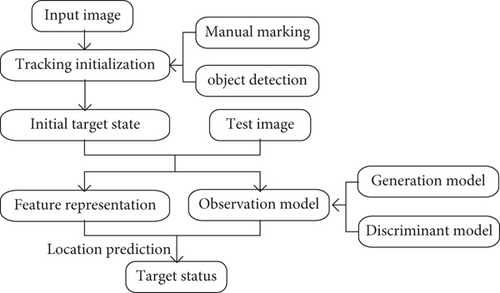
In formula (9), R, G, and B refer to the vector representation of each dimension on the image, and index refers to the mapping index of RGB on dd50. The flow of dh-kcf algorithm is shown in Figure 2.

3.2. Application of Multifeature Correlation Filter Algorithm in Basketball Motion Capture/Algorithm Optimization
In formula (15), W represents the sample weight set, γ represents the adaptive sample weight value obtained according to PSR, A represents the historical filter set, and X represents the historical target feature set. Dhcf-as algorithm uses the initial image position to train the filter in the first frame, and then, each frame uses the target position of the previous frame for detection and updates the target position through the maximum response value.
4. Test Results of Kernel Correlation Filtering Algorithm Based on Multiple Color Features
4.1. Performance Test of Improved dhcf Algorithm Based on KCF Algorithm
In the algorithm performance test experiment, the KCF algorithm uses dd-hog feature and three general features such as hog, cn-hog, and CN for target tracking test, so as to compare the target tracking performance of the four features (the KCF algorithm using dd-hog feature is the dhcf algorithm proposed in this study). In this experiment, otb50 and otb100 are used as test datasets. Otb50 represents 50 groups of video frame sequences, and otb100 represents 100 groups of video frame sequences. The comparison of the four features in target tracking accuracy and target tracking success rate is shown in Figure 3.
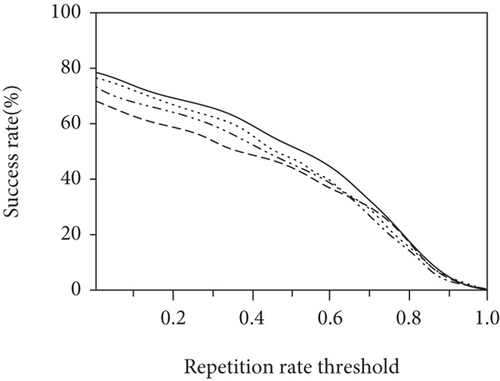
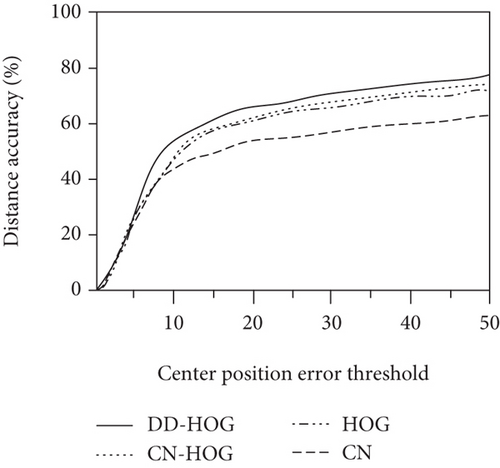
As can be seen from Figure 3(a), in the comparison of tracking success rate, the tracking success rate of dd-hog feature can reach 78.2%, followed by cn-hog feature, which is 76.3%. Hog feature and CN feature have lower tracking success rates, which are 73.4% and 68.2%, respectively. As can be seen from Figure 3(b), the tracking accuracy of dd-hog is still the highest among the four features, which is 75.1%. The tracking accuracy of cn-hog and hog features is similar, 70.2% and 69.7%, respectively. The tracking accuracy of CN feature is the weakest, only 60.2%. Therefore, compared with the traditional KCF algorithm using only hog feature, the dhcf algorithm using dd-hog feature improves the target tracking success rate by 4.8% and the tracking accuracy by 5.4%. Dhcf algorithm which combines hog feature and color feature has better performance than traditional algorithm. In order to test the target tracking performance of dhcf algorithm in complex scenes, this study will test the tracking success rate of dhcf algorithm in several scene attributes. Several conventional scenes are background clutter (BC), fast motion (FM), in-plane rotation (IPR), and out of plane rotation (OPR). The experimental results are shown in Figure 4.
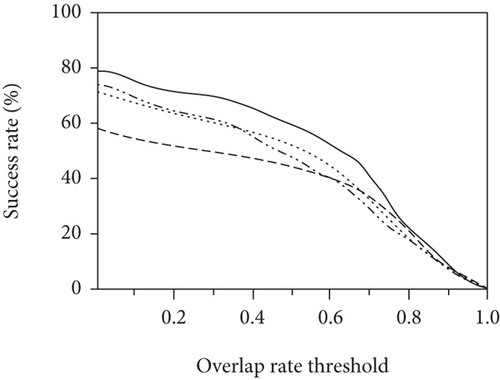
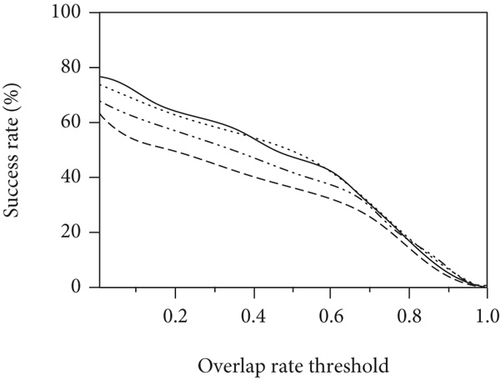
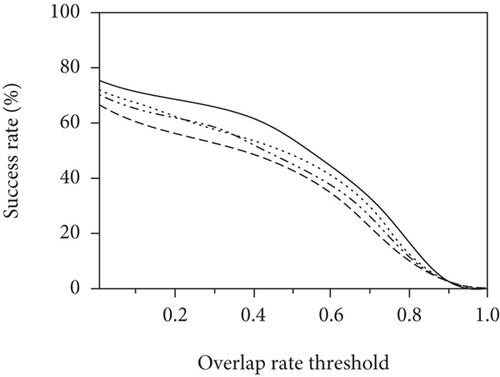
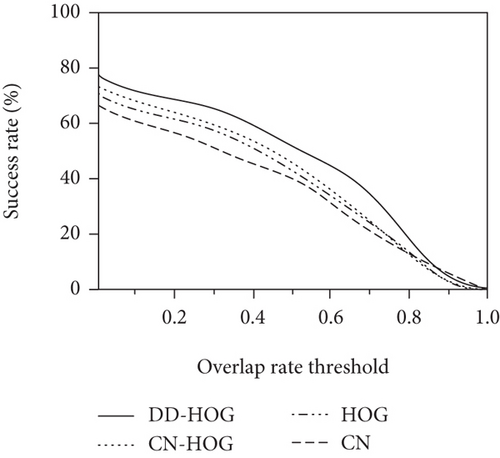
Figure 4 shows that the dd-hog feature has obvious advantages in the scene attributes of background clutter, in-plane rotation, and out of plane rotation. Its tracking success rates are 78.6%, 77.2%, and 72.8%, respectively, which is 2.3% higher than that of the slightly lower level feature. Dd-hog has no obvious advantage only in fast-moving scene attributes, and the tracking success rate is 1.2% higher than that of cn-hog. The KCF algorithm with four different features will be compared in four scene attributes: target deformation (DEF), target occlusion (OCC), scale variation (SV), and illumination variation (IV). The results are shown in Figure 5.

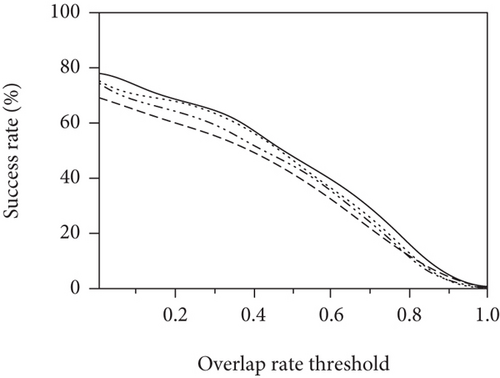
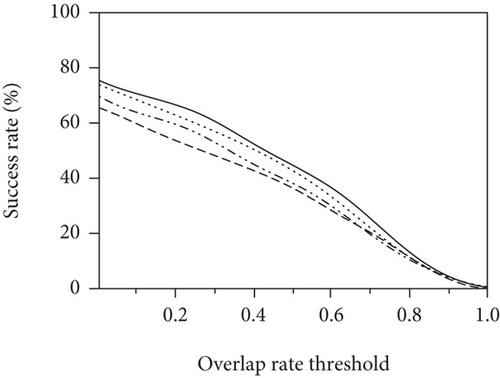
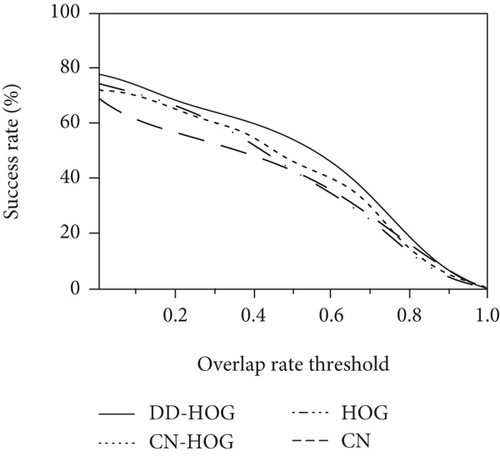
Figure 5 shows that dd-hog algorithm still has the best tracking success rate compared with the other three features in the scene attributes of DEF, OCC, SV, and IV, which are 76.3%, 77.6%, 73.5%, and 79.1%, respectively. Therefore, dhcf algorithm using dd-hog as color feature can use different scene attributes and show excellent target tracking effect. Dhcf algorithm solves the tracking ambiguity problem caused by scene changes in traditional algorithms to a certain extent, so as to improve the efficiency and robustness of the algorithm.
4.2. Effect Test of Improved dhcf-as Algorithm in Target Tracking
This study uses MATLAB software to run dhcf and dhcf-as algorithms. In order to verify the application effect of dhcf-as algorithm in target tracking, CN, KCF, dhcf, and dhcf-as algorithms are compared in otb50 and otb100 test sets. Among the algorithm parameters, the Gaussian kernel bandwidth is 0.5, the regularization term is 10-4, and the update rate is determined according to the PSR value. The size of hog cell is 9 bins, and the size of hog block is 4 cells. The comparison results are shown in Figure 6.
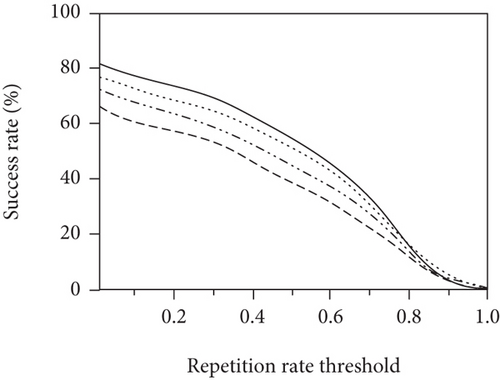
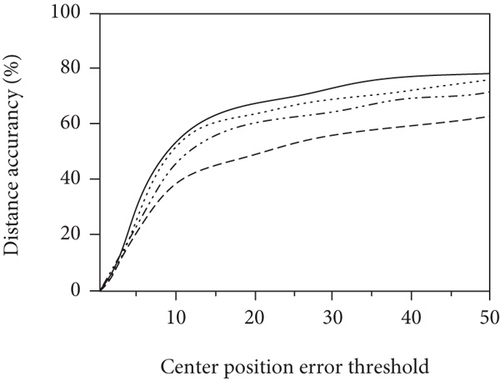
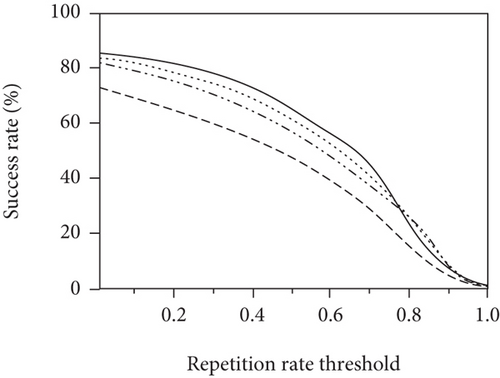
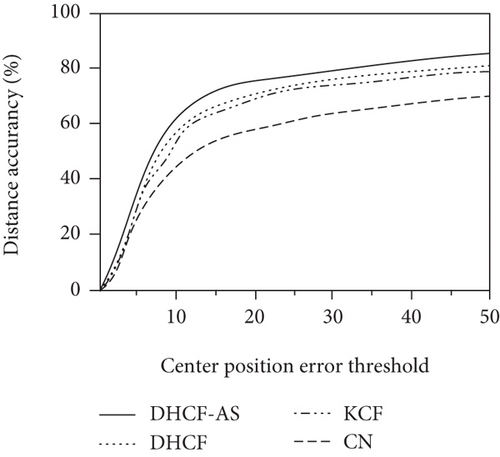
As can be seen from Figure 6, in the otb50 test set, the tracking success rate of dhcf-as algorithm can reach 80.9%, and the tracking success rate in otb100 can reach 84.2%. The tracking accuracy of dhcf-as algorithm in otb50 and otb100 is 79.2% and 82.5%, respectively. In the two test sets, the performance of dhcf-as and dhcf algorithms is higher than that of KCF and CN, and dhcf-as has more advantages than dhcf. In otb50, the tracking success rate of dhcf-as algorithm is 4.2% higher than that of dhcf algorithm, and the tracking accuracy is 1.7% higher than that of dhcf algorithm. In order to test the performance of dhcf-as algorithm in different scene attributes, the tracking results of four algorithms in different scene attributes are compared. The comparison results of tracking success rate and accuracy values of the four algorithms are shown in Figure 7.
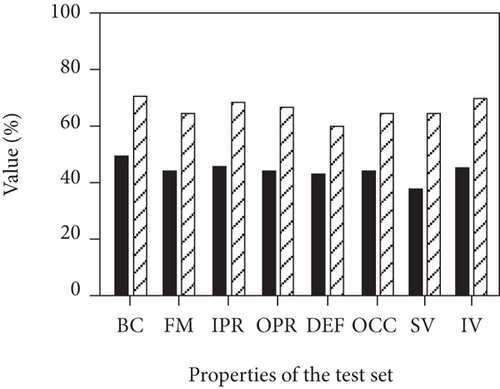
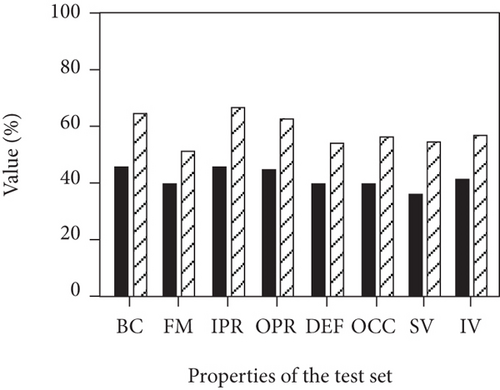
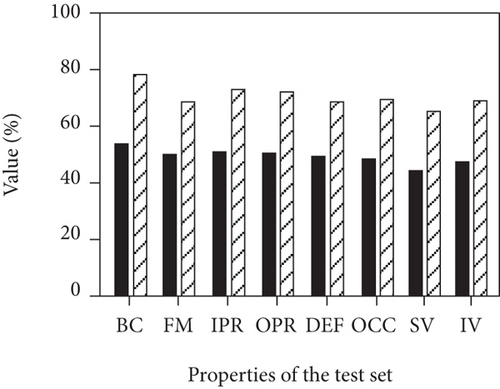
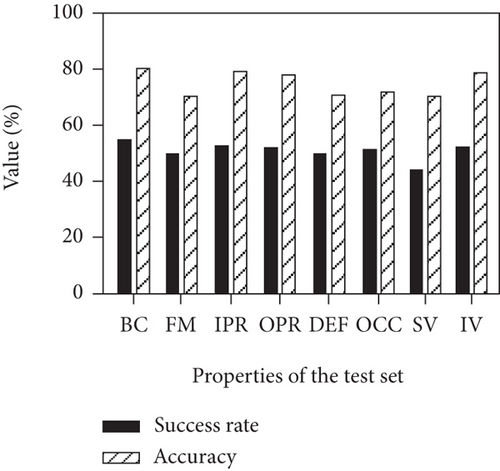
As can be seen from Figure 7, dhcf-as has the highest tracking success rate of 56.5% in BC scene attributes and the lowest success rate of 44.7% in SV scene attributes. In the SV scenario, dhcf algorithm has the highest success rate, with a value of 47.3%, which is 2.6% higher than dhcf-as algorithm. The tracking success rate of dhcf-as algorithm in SV scene is lower than that of dhcf algorithm, but it is still higher than that of KCF and CN algorithms. In addition, dhcf-as algorithm has the best tracking success rate and tracking accuracy among several scene attributes. Therefore, compared with the traditional algorithm and the improved algorithm, the improved dhcf-as algorithm has more advantages in tracking performance. However, dhcf-as algorithm needs further improvement. The algorithm can be applied in other scenes. Compared with CN hog, hog, and CN, dhcf algorithm can show the highest tracking performance in various scenarios. Among various scene attributes, dhcf as algorithm has the best tracking performance. Only in the scene of scale change, its tracking performance is lower than that of dhcf algorithm. Therefore, in the future experiments, we should enhance its adaptability under the scale change scenario. It is necessary to improve its adaptability to scale changes and its tracking performance.
5. Conclusion
In order to improve the performance of basketball motion capture system, based on kernel correlation filtering algorithm, this paper proposes a dhcf as algorithm based on multicolor features, which mainly studies the adaptability of traditional KCF algorithm in scene attributes such as rapid target change and illumination change. The experimental results show that the tracking success rate of dhcf algorithm combined with multiple color features can reach 78.2% and the tracking accuracy can reach 75.1%. Compared with CN hog, hog, and CN [21], DD hog can show the highest tracking performance in various scenarios. The tracking success rate and accuracy of the improved dhcf as algorithm in otb50 test set are 80.9% and 79.2%, respectively, and in otb100 test set are 84.2% and 82.5%, respectively. Among various scene attributes, dhcf as algorithm has the best tracking performance. Only in the scene with scale change, its tracking performance is lower than dhcf algorithm. Therefore, in future experiments, dhcf as algorithm will be further improved to enhance its adaptability in scale change scenarios.
In this paper, the adaptive sample set is applied to the original kernel correlation filter. When the target moves too fast or is blocked, it is easy to form a large amount of invalid and redundant information, which affects the target tracking efficiency of the algorithm. The adaptive sample set can filter these interference information, so as to improve the target tracking accuracy and real-time performance of the motion capture system. The research has some limitations; for example, the paper does not simulate the filtering algorithm and so on. Therefore, further modifications are needed in future research.
Conflicts of Interest
The author declared that they have no conflicts of interest regarding this work.
Open Research
Data Availability
The experimental data used to support the findings of this study are available from the corresponding author upon request.




